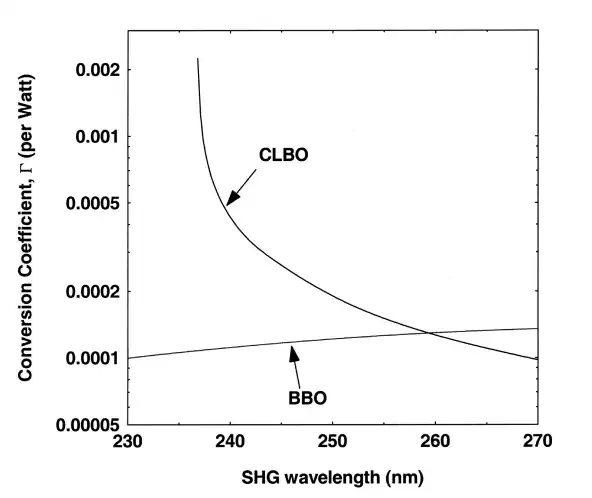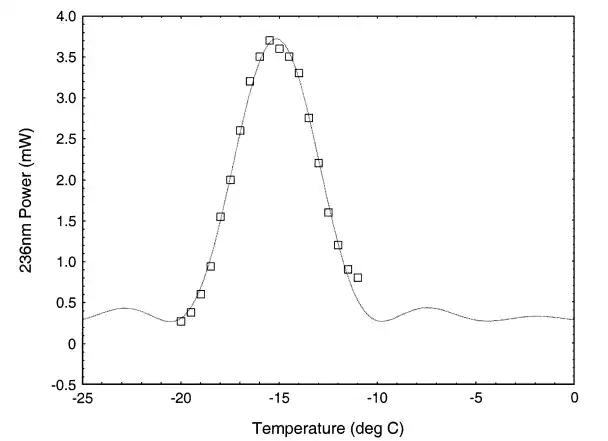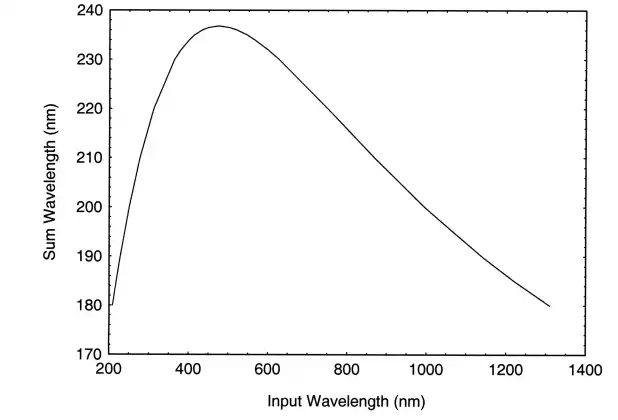Noncritically phase-matched second-harmonic generation in CLBO Crystals
Efficient generation of 236-nm light was demonstrated by use of noncritically phase-matched second-harmonic generation in CLBO crystals (cesium lithium borate). Noncritical phase matching provided approximately 203 the nonlinear drive for second-harmonic generation than b-barium borate for 236-nm generation. The 236-nm wavelength is the fourth harmonic of a 946-nm Nd:YAG laser. Phase matching was accomplished at a crystal temperature of 215 ±℃.
Generation of ultraviolet light by use of diode-pumped 1-mm solid-state lasers and harmonic generation with nonlinear optical crystals has resulted in a variety of commercial laser products and industrial applications. The primary nonlinear optical crystals for generation of ultraviolet light are from the borate class[1–4].These include lithium triborate, b-barium borate (BBO), and cesium lithium borate (CLBO). Recently, average powers near 20 W at 266 nm (Ref. 1) and near 15 W at 255 nm (Ref. 2) were obtained with CLBO. Conversion efficiencies for these systems approached 30%.
In general, the nonlinear drive for the borate crystals for fourth- and fifth-harmonic generation by use of 1-mm neodymium lasers is relatively low.This is so primarily because of the relatively small value of the nonlinear coefficient compared with those of crystals (such as KTP, lithium niobate, and periodically poled materials) for generation of visible light and also because of Poynting vector walk-off. Thus, efficient nonlinear conversion that uses borates requires high-peak-power lasers or power enhancement in external resonators[3],4 For example, Okaet al. reported 52% efficient continuous-wave generation of 266-nm UV light when they used BBO in an external resonator.3 Knittel and Kung used an external resonator and a diode-pumped Q-switched Nd:YAG Laser system to generate 266-nm light with 30% efficiency [4] Chang et al. utilized a similar scheme to generate the 213-nm fifth harmonic at 7.5% efficiency [5] In this Letter we report what is to our knowledge the first efficient generation of 236-nm light by use of a diode-pumped 946-nm Nd:YAG laser and noncritically phase-matched (NCPM) second-harmonic generation in CLBO.
The nonlinear drive for harmonic generation can increase dramatically as phase matching in the nonlinear crystal approaches the noncritical condition, i.e., when propagation in the crystal is parallel to one of the principal axes of the crystal. Figure 1 shows nonlinear conversion coefficient G for second-harmonic generation for CLBO and BBO as a function of the secondharmonic wavelength. Here the nonlinear conversion coefficient is defined according to the formalism summarized by Kozlovsky et al [6] and assumes no depletion of the fundamental. Each point on the curves for the CLBO and BBO crystals incorporates optimum focusing into each crystal, including the effects of walk-off. A crystal length of 10 mm is assumed.
 Fig.1. Nonlinear conversion coefficient for CLBO andBBO versus SHG wavelength
Fig.1. Nonlinear conversion coefficient for CLBO andBBO versus SHG wavelength
For 266-nm generation (second harmonic of 532-nm and fourth harmonic of 1064-nm Nd:YAG), BBO has a slightly larger nonlinear conversion. At shorter wavelengths the nonlinear conversion coefficient for CLBO increases rapidly, whereas that of BBO is relatively level. As phase matching approaches a noncritical point for the CLBO crystal, focusing becomes tighter; it reaches a maximum at the NCPM point. At this point, the conversion coefficient for second-harmonic generation is approximately 2x10-3/W for CLBO, compared to approximately 1.1x10-4/W for BBO.
We tested the noncritical phase-matching point in CLBO, using the 473-nm second harmonic of a diode-pumped 946-nm Nd:YAG laser. Solid-state neodymium lasers near 900 nm have received renewed interest recently for potential display applications for their blue second-harmonic wavelengths.7,8 The experimental arrangement of the 946-nm laser is shown in Figure. 2. The pump laser was a fiber-coupled diode laser from Limo GmbH. This source provided as much as 25 W of power from a 200-mm-diameter aperture with a numerical aperture of 0.22. The output of the fiber was imaged with 1:1 magnification through a high-ref lector mirror for the Nd:YAG laser and into a composite Nd:YAG crystal from CRYSMIT. The Nd:YAG crystal had a 3-mm neodymium-doped section sandwiched between two 3-mm-long undoped YAG end caps. Approximately 75% of the diode pump light was absorbed in the Nd:YAG crystal. The remainder of the 946-nm laser consisted of a curved and a f lat high-ref lector mirror, a polarizer, an acousto-optic Q switch (Gooch and Housego), and a 15% transmitting output mirror. All mirrors for the Nd:YAG laser had high transmission for 808 nm (.95%), 1064 nm (.80%), and 1319 nm (.50%). The high-ref lector mirrors had reflectivities of .99.9% at 946 nm. At a pulse-repetition frequency of 50 kHz, the 946-nm laser provided 2.7-W average power for 18 W of diode pump power. The output pulse’s duration was 95 ns. Beam quality was good, with measured M2 = 1.01.
 Fig. 2. Schematic diagram of a diode-pumped Q-switched 946-nm NdYAG laser HR, highly ref lective.
Fig. 2. Schematic diagram of a diode-pumped Q-switched 946-nm NdYAG laser HR, highly ref lective.
The 473-nm second harmonic was generated with a 10-mm periodically poled KTP crystal from Cobolt AB. This crystal had a poling period of 6.09 mm, as specified by the vendor. Stable blue-light generation near room temperature (20 ±℃) was observed at average blue powers near 100 mW, but power loss and degradation of the crystal were observed for average blue powers near 200 mW.
The blue output was focused into a 10-mm CLBO crystal from Crystal Associates. The CLBO crystal was cut with angles of theta=90° and Phi=45° To protect the hydroscopic CLBO crystal from moisture, we contained the crystal in a vacuum-tight vessel with Brewster-angled input and output windows oriented to minimize ref lection loss for the blue input light and the orthogonally polarized 236-nm output light. After high-temperature (150 ±℃) vacuum processing of the crystal and the vacuum vessel for 72 h, the vessel was backfilled with dry nitrogen at atmospheric pressure and sealed.
The variation of 236-nm output signal as a function of crystal temperature is shown in Figure. 3. The phase-matching temperature was 215 ±℃. The full width at half-maximum of the sinc2 functional fit to the experimental data points was 5.0 ±℃ for the 10-mm-long crystal. A maximum 236-nm average power of 27 mW at 30 kHz was captured for 200 mW of average 473-nm power incident upon the CLBO crystal. This corresponds to an average UV power of 43 mW in the CLBO crystal, with Fresnel reflection losses on the uncoated exit face of the CLBO crystal (T = 95%), an uncoated fused-silica lens (T = 92%), and improper polarization on a fused-silica Pellin–Broca prism used to separate the UV from the residual blue light taken into account. Total reflection losses for the 236-nm light generated in these experiments were 37%.
 Fig. 3. Temperature-dependent phase-matching curve for NCPM 236-nm generation in CLBO.
Fig. 3. Temperature-dependent phase-matching curve for NCPM 236-nm generation in CLBO.
The average blue power inside the CLBO crystal was approximately 190 mW, which corresponds to a 473–236-nm conversion efficiency of 22.6%. The conversion efficiency is the product of nonlinear conversion coefficient G and the peak blue power. At 30 kHz the blue pulse energy was 6.3 mJ. The measured pulse duration was 53 ns. This value corresponds to a peak blue power (pulse energy divided by pulse duration) in the CLBO crystal of 119 W. Thus the experimental value for G is 1.9x10-3/W, in excellent agreement with theory.Reliable operation of CLBO at high UV powers has been demonstrated at temperatures near 140 ±℃.1 An important question is whether CLBO can be reliable at the 215 ± ℃ phase-matching temperature for 236-nm generation. Life tests to demonstrate reliable operation of CLBO at 215 ±℃ are under way.
It should be possible to generate UV light efficiently at wavelengths shorter than 236 nm in CLBO by sum-frequency mixing (SFM). Figure 4 shows the variation of SFM wavelength versus input wavelengths for NCPM SFM in CLBO. The longest SFM wavelength at 236 nm corresponds to frequency doubling of 473-nm light, and shorter SFM wavelengths can be generated by mixing of one wavelength less than 473 nm and one wavelength greater than 473 nm. One interesting SFM interaction indicated in Fig. 4 is the SFM of 236- and 1080-nm light to generate a sum wavelength near 193 nm.
 Fig. 4. NCPM sum-frequency-mixing curve for CLBO.
Fig. 4. NCPM sum-frequency-mixing curve for CLBO.
In conclusion, noncritically phase-matched secondharmonic generation in cesium lithium borate has been demonstrated. Generation of the fourth harmonic of a 946-nm Nd:YAG laser was demonstrated at 215 ±℃. The relatively large nonlinear drive for 236-nm generation in CLBO provides for higher conversion efficiency for continuous-wave and high-repetition-rate Q-switched lasers. The larger nonlinear conversion coefficient also provides for high efficiency at lower intensities in CLBO crystals by use of high-peak-power lasers, providing for longer crystal operating lifetimes.
Diode-pumped 946-nm Nd:YAG laser development was supported by the National Science Foundation through Small Business Innovation Research (SBIR) Phase II program DMI-0078664 and by the NASA Langley Research Center through SBIR Phase II program NAS1-01097. The authors also acknowledge the mechanical engineering design contribution of Fritz Stahr. D. C. Gerstenberger.
References
[1]. T. Kojima, S. Konno, S. Fujikawa, K. Yasui, K. Yoshizawa, Y. Mori, T. Sasaki, M. Tanaka, and Y.Okada, Opt. Lett. 25, 58 (2000).
[2]. D. J. W. Brown and M. J. Withford, Opt. Lett. 26, 1885 (2001).
[3]. M. Oka, L. Liu, W. Weichmann, N. Eguchi, and S.Kubota, IEEE J. Sel. Top. Quantum Electron. 1, 859 (1995).
[4]. J. Knittel and A. H. Kung, IEEE J. Quantum Electron.33, 2021 (1997).
[5]. L. B. Chang, S. C. Wang, and A. H. Kung, Opt. Commun.209, 397 (2002).
[6]. W. J. Kozlovsky, C. D. Nabors, and R. L. Byer, IEEE J.Quantum Electron. 24, 913 (1988).
[7]. M. Pierrou, F. Laurell, H. Karlsson, T. Kellner, C.Czeranowsky, and G. Huber, Opt. Lett. 24, 205 (1999).
[8]. P. Zeller and P. Peuser, Opt. Lett. 25, 34 (2000).















